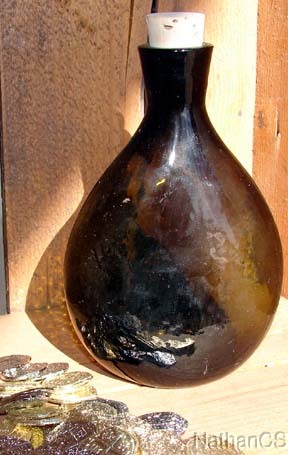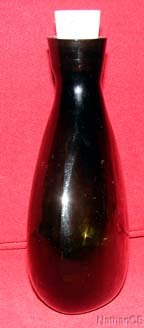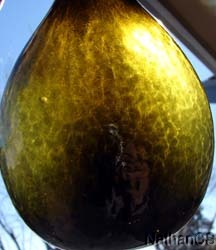17th Century Pirate Grog Flask
Replica of an artifact found at Port Royal the famed Pirate city of the Caribbean. This handblown green glass flask would have been used for grog or other liquids. 6.25" tall and 4" wide. Comes with cork and ready for use.
Please do not put handblown glass items in dishwashers or ovens, they are sensitive to tempature.
Port Royal was a city located at the end of the Palisadoes at the mouth of the Kingston Harbour, in southeastern Jamaica. It was the centre of shipping commerce in the Caribbean Sea during the latter half of the 17th century. It was one home port of the privateers employed to nip at superpower Habsburg Spain's empire when smaller European powers dared not directly make war on Spain. As a port city, it was notorious for its gaudy displays of wealth and loose morals, and was a popular place and base (homeport) for the English and Dutch sponsored privateers to bring and spend their treasure during the 17th century. When those governments abandoned the practice of issuing letters of marque against the Spanish treasure fleets and possessions in the later 16th century, many privateers turned pirate and used the city as their main base during the heyday of the Caribbean pirates in the 17th century. During the 16th century, the English and French actively encouraged and even paid buccaneers based at Port Royal to attack Spanish and French shipping. Pirates from around the world congregated at Port Royal coming from waters as far away as Madagascar on the far side of Africa.
In archaeology, Port Royal is the site of the only earthquake which can be dated closely by not only date, but time which is documented by recovery from the sea floor in the 1960s of a pocket watch stopped at 11:43 a.m. recording the time of the devastating earthquake shortly before[1][2] on June 7, 1692, largely destroying Port Royal, causing two thirds of the city to sink into the Caribbean Sea such that today it is covered by a minimum of 25 ft (8 m) of water. Known today to 16th -18th-century focused archaeologists as the "City that Sank"[3], it is considered the most important underwater archaeological site in the western hemisphere, yielding 16th-17th-century artifacts and many important treasures from indigenous peoples predating the 1588 founding, some from as far away as Guatemala. Several 17th and early 18th century pirate ships sank within Kingston Harbour and are being carefully harvested under controlled conditions by different teams of archaeologists. Other "digs" are staked out along various quarters and streets by different teams.



















